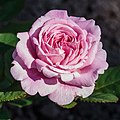
Garden roses are predominantly hybrid roses that are grown as ornamental plants in private or public gardens. They are one of the most popular and widely cultivated groups of flowering plants, especially in temperate climates. An enormous number of garden cultivars have been produced, especially over the last two centuries, though roses have been known in the garden for millennia beforehand. While most garden roses are grown for their flowers, often in dedicated rose gardens, some are also valued for other reasons, such as having ornamental fruit, providing ground cover, or for hedging.
Sam McGredy refers to four generations of Northern Irish rose hybridizers. Sam McGredy I founded the family nursery in 1880. Sam McGredy II focused the nursery on roses in 1895. Sam McGredy III took over in 1926, and was the first to name roses after family members. Sam McGredy IV moved operations to New Zealand in 1974 after a close friend was murdered by Loyalist paramilitaries during The Troubles, and focused on Floribundas, Hybrid Teas and Grandifloras, including 'Paddy Stephens', 'New Zealand', and 'Kathryn McGredy'; and the hand-painted roses such as 'Regensberg'.

The Rosa 'George Burns' is a yellow and red striped Floribunda rose cultivar, developed in the United States by Tom Carruth in 1996. The rose was introduced in 1997 by Spring Hill Nurseries.

Rosa 'Handel',, is a climbing floribunda rose cultivar, developed by Samuel McGredy IV in 1960. The cultivar was the recipient of the Portland Gold Medal in 1975.

Rosa 'Olympiad',, is a hybrid tea rose cultivar, developed by Sam McGredy IV, and introduced into New Zealand by McGredy Roses International in 1974. The cultivar was named an All-America Rose Selections winner in 1984, and the recipient of the Portland Gold Medal in 1995.
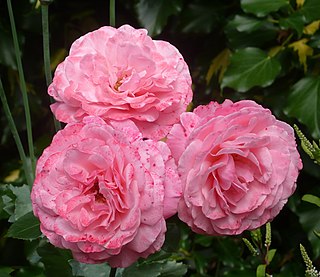
Rosa 'Sexy Rexy',, is a multiple-award winning floribunda rose cultivar, developed by Sam McGredy IV, and introduced into New Zealand by McGredy Roses International in 1984. The stock parents of this rose are the hybrid musk, Rosa 'Seaspray' and the floribunda, Rosa 'Dreaming'.

Rosa 'Dublin Bay' is a red, large-flowered floribunda climbing rose. The rose cultivar was bred by Sam McGredy IV in 1969 and introduced into Ireland by nursery, Samuel McGredy and Son.
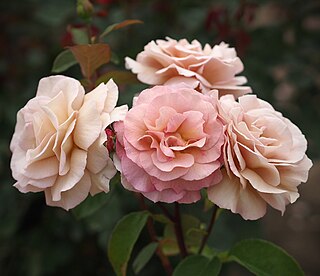
Rosa 'Spiced Coffee' is a pale beige hybrid tea rose with pink edges. The rose cultivar was bred by Sam McGredy IV in 1985 and introduced into New Zealand in 1990 by his nursery, McGredy Roses International.

Rosa 'Maggie Barry' is a pink blend hybrid tea rose with dark salmon edges. The rose cultivar was bred by Sam McGredy IV in 1986 and introduced into New Zealand in 1993 by McGredy Roses International.

Rosa 'Soleil d'Or' is a Foetida hybrid rose cultivar, bred by Joseph Pernet-Ducher and introduced on November 1, 1900. It is the ancestor of all modern Hybrid tea roses and the first yellow-orange rose. Pernet-Ducher later crossed 'Soleil d'Or' with Tea roses to create a new class known as Pernetiana roses.

Rosa 'Madame Caroline Testout' is a bright pink hybrid tea rose, bred by French rosarian, Joseph Pernet-Ducher. The pink, fragrant rose has been a very popular rose worldwide since its introduction in 1890. It is recognized by the city of Portland as being an important contributor to its worldwide reputation as the "City of Roses"

Rosa 'Souvenir de Claudius Pernet' is a medium yellow Hybrid tea rose, bred by French rose breeder, Joseph Pernet-Ducher before 1919. He named the rose for his son Claudius, who was killed in action in World War I. 'Souvenir de Claudius Pernet' is one of the ancestors of the famous 'Peace' rose.
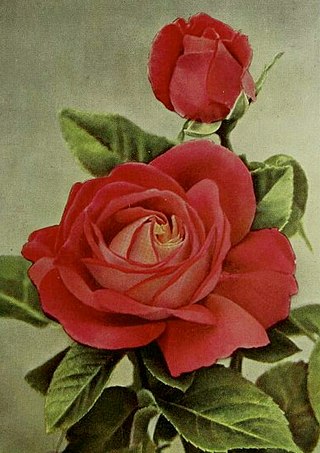
Rosa 'Margaret McGredy' is an orange-red hybrid tea rose, bred by Irish rose breeder Sam McGredy III before 1925. The new rose was awarded the Royal National Rose Society (RNRS) Gold Medal in 1925, but was never commercially successful. 'Margaret McGredy, along with an unnamed seedling, was used to hybridize the legendary hybrid tea rose, 'Peace'.

Rosa 'Joanna Hill' is a yellow hybrid tea rose, bred by American rose breeder, Joseph H. Hill in 1928. 'Joanna Hill is one of the ancestors of the legendary hybrid tea rose, 'Peace'.
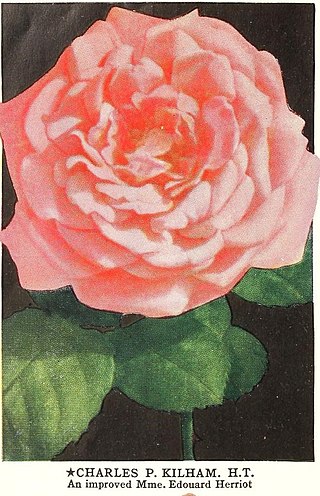
Rosa 'Charles P. Kilham' is an orange-red hybrid tea rose, bred by Irish rose breeder, Samuel McGredy III before 1926. The rose was introduced in France in 1926 and Australia in 1927. It won the Royal National Rose Society (RNRS) gold medal in 1927. 'Charles P. Kilham' is one of the ancestors of the legendary hybrid tea rose, 'Peace'.
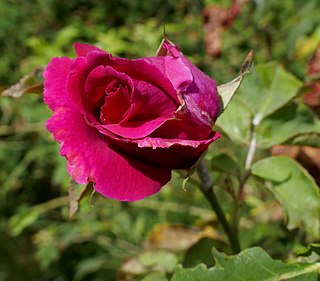
Rosa 'George Dickson' is a medium red hybrid tea rose bred by Alexander Dickson II of Northern Ireland in 1912. It was one of the Dickson nursery's early commercial successes and was a popular rose with the public. It was awarded the Royal National Rose Society (RNRS) gold medal in 1911 and is an ancestor of the legendary 'Peace' rose.

Rosa 'Baroness Rothchild' is a pink Hybrid Perpetual rose cultivar, bred by Jean Pernet in 1868 and introduced in Australia by St. Kilda Nurseries in 1873 as 'Baroness Rothschild'.

Rosa 'Brass Band' is an orange blend Floribunda cultivar, bred by American hybridizer, Jack E. Christensen in 1993. It was introduced in the United States by Jackson & Perkins Co. in 1994. The cultivar was named an All-America Rose Selections (AARS) in 1995.
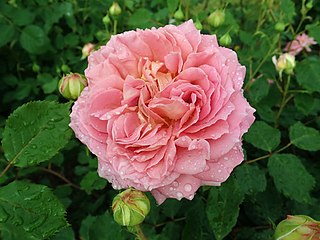
Rosa 'Jubilee Celebration' is a coral-pink shrub rose cultivar, created by British rose breeder David C. H. Austin in 1993. The rose was named in honor of the Golden Jubilee of Elizabeth II in 2002. The rose was introduced into the UK by David Austin Roses Limited (UK) in 2002.





















